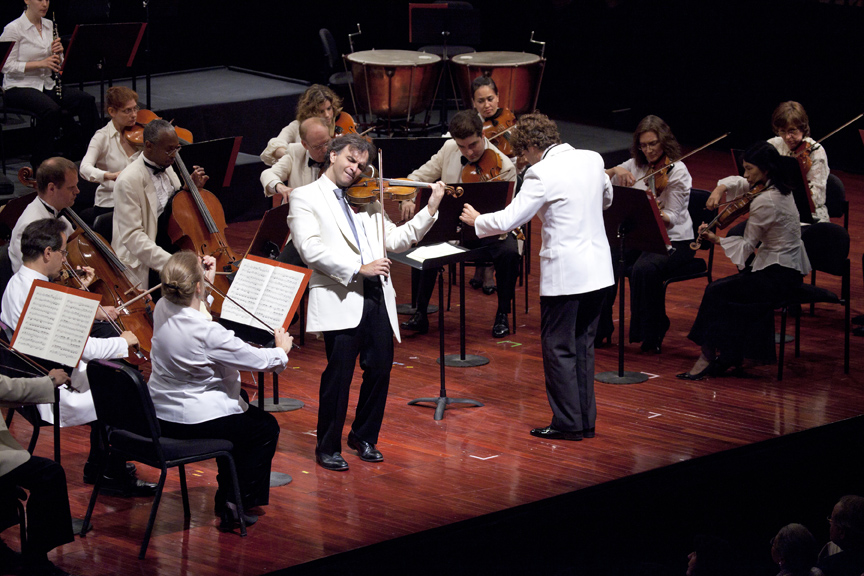Mostly Mozart Festival
Mostly Mozart Festival Orchestra Pablo Heras-Casado, conductor Gil Shaham, violin Avery Fisher Hall, New York, NY August 4, 2010
PABLO HERAS-CASADO, conductor; GIL SHAHAM, violin with the MOSTLY MOZART FESTIVAL ORCHESTRA – PHOTO CREDIT – Richard Termine
This was one of the Festival’s “Some Mozart” programs; one third Mozart, to be exact. Mozart’s contribution was the Violin Concerto No. 5 in A major, K.219, the last, and probably the greatest, of his authentic works in that genre. It was performed by Gil Shaham, winner of the 1990 Avery Fisher Career Grant and the 2008 Avery Fisher Award, and one of the most appealing, versatile virtuosos before the public. Among his most captivating qualities are his charm and spontaneity, and, along with his brilliant technique and luxurious tone, they were on full display at this concert. Indeed, it may be his boundless facility that tempts him to succumb to today’s rampant infatuation with excessive speed. The Concerto’s slow movement was lovely, but the first, though clear, was rather hectic and over-accented; the Rondo lost much of its gracious courtliness, and the “Turkish” interlude raced past like a furious sandstorm. In the Joachim cadenzas, the runs were too fast for human ears. However, the fireworks brought the audience to its feet, eliciting an encore that turned out to be a piece related to the Mozart concerto by its Turkish roots, which Shaham recently heard in Istanbul. A relentless, super-fast marathon run-around, it sounded, to the uninitiated listener, like a Klezmer dance on speed.
The program began with Stravinsky’s “Dumbarton Oaks” Concerto, written in 1937 to celebrate the 30th wedding anniversary of the owners of that grand estate, where the United Nations were founded seven years later. Supposedly modeled on Bach’s Brandenburg Concertos, the Dumbarton Oaks Concerto is in three movements, all full of Stravinsky’s characteristic quirky, irregular rhythms and spicy harmonies. The first and third movements are bustling and dissonant; the second is a charming, leisurely, dance-like Allegretto. The 15 orchestral soloists played splendidly—singly and together.
Mostly Mozart has established an admirable policy of inviting rising young conductors, and this concert introduced the Spanish-born Pablo Heras-Casado in his Festival debut. Though only 32-years-old, he has conducted music from the 17th century to the immediate present in opera houses and concert halls all over the world; his American debut took place in 2008 at Carnegie Hall with the ACJW Ensemble (The Academy of Carnegie Hall, the Juilliard School and the Weill Music Institute). All this experience has given him a style that is confident but not showy, authoritative but not authoritarian. He handled the changing rhythms and textures of the Stravinsky expertly, with sparing, efficient gestures; unfortunately, in the concerto, he frequently allowed the orchestra—especially the winds—to cover the soloist.
Beethoven’s Symphony No. 2, Op. 36, which closed the program, was also efficient, but—again in conformity with current trends—very fast, with excessive dynamic contrasts and sharp, aggressive accents, giving the music no chance to breathe or speak for itself. However, the brilliant Finale elicited a prolonged, vociferous ovation.
